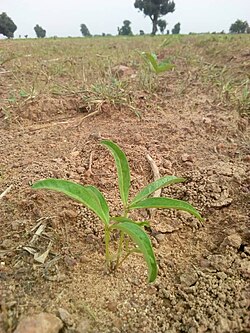Typical yield
0.8 t/ha
Varieties
1
Pest/Disease
4
Seasons
2
Profile
- Growth habit
- annual
- Lifecycle (days)
- 100–150
- Primary uses
- Pulse/legume; fresh or dry seed; food security
- Pollination
- self
- Origin / distribution
- Sub-Saharan Africa; widely grown in semi-arid areas
Environment
Climate
Temp optimal
22–30 °C
Rain optimal
500–900 mm/yr
Altitude
0–1600 m
Soil
pH optimal
5.5–6.8
Soil type
Sandy loam to light loam; loose soils for pegging
Farmer Guide
Row spacing
60 cm
Plant spacing
30 cm
Depth
4 cm
Seed rate
50 kg/ha
Nursery days
Planting: Direct seed into warm, moist soil; inoculate with compatible rhizobia where available; keep weed-free during early growth.
Transplanting: Not transplanted; direct seeding recommended.
Irrigation: Moderate water demand; ensure moisture at flowering and pod set; avoid waterlogging.
Fertigation: Minimal N required due to fixation; supplement P and K on poor soils.
Pest scouting: Scout weekly for aphids, beetles, and foliar diseases; use sanitation and rotation.
Pruning/Training: Not required; low bush habit.
Harvest: Harvest when pods are fully filled and leaves begin yellowing; dry pods adequately before shelling.
Postharvest: Dry to safe moisture; store in airtight containers; control bruchids if present.
Nutrient Schedule
| # | Stage | DAP | Product | Rate | Targets (kg/ha) | Notes |
|---|---|---|---|---|---|---|
| 1 | Basal | 0 | DAP 18-46-0 | 60 kg/ha | N: —, P₂O₅: —, K₂O: — | Band or place below seed; avoid seed burn |
Nutrient Requirements
| Nutrient | Stage | Amount | Unit |
|---|---|---|---|
| P₂O₅ | Basal | 25 | kg/ha |
| K₂O | Basal | 20 | kg/ha |
| N | Topdress | 0 | kg/ha |
Images

| Name | Country | Maturity | Traits |
|---|---|---|---|
| Local Bambara | KE | 130 | Drought tolerant; good seed fill |
| Stage | Product | Rate (kg/ha) | Notes |
|---|---|---|---|
| Basal | DAP 18-46-0 | 60 | Reduce if soil P is high |
| Name | Type | Symptoms | Management |
|---|---|---|---|
| Aphids | pest | Stunting, honeydew | Encourage natural enemies; spot sprays if thresholds exceeded |
| Bruchids (storage) | pest | Holes/larvae in stored grains | Proper drying; hermetic storage; insecticidal dusts where appropriate |
| Leaf spots | disease | Necrotic foliar lesions | Rotation; sanitation; avoid overhead irrigation |
| Root rots | disease | Wilting, root decay | Improve drainage; avoid planting in poorly drained fields |
| System | Typical | Min | Max | Notes |
|---|---|---|---|---|
| rainfed smallholder | 0.8 | 0.4 | 1.5 |
| Country | Region | Planting | Harvest |
|---|---|---|---|
| KE | Western | Mar–Apr | Jul–Sep |
| KE | Eastern (short rains) | Oct–Nov | Jan–Mar |
| Country | Region | Suitability |
|---|---|---|
| KE | Eastern (semi-arid pockets) | Medium |
| KE | Western | High |
| TZ | Central semi-arid | High |
| UG | Northern | Medium |
